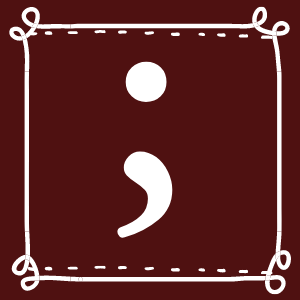|
There are some pieces of punctuation that most of us have mastered. For example, it would be difficult to make it out of grade school without knowing how to use a period or a question mark. However, our education tends to have a few more holes when it comes to something like semicolons. Many writers avoid using them altogether for one of two reasons: the writer finds them too formal and stuffy for their work, or they don’t feel confident in how to use semicolons correctly. The first is just not true, and the second is easily fixed. Semicolons are stuffy and boring. It’s true that semicolons are more common in formal writing, such as academic or instructional writing, but that’s mainly due to the higher complexity of the sentences, not the formality of the punctuation itself. Your word choice and sentence structure affect the tone of your writing more than the use of certain punctuation marks. There are writers from all genres who use semicolons in their work—from romance to sci-fi and fantasy to thrillers—and still manage to enthrall their audiences. They’re confusing, and I don’t understand how to use them. I think we’re all aware that the public education system has a few holes in it. But you don’t need some advanced degree to master the semicolon. You just need to be interested and willing to learn. There’s no shame in ignorance, only in complacently accepting it. Chances are, if you read much (and if you aspire to become a writer, you absolutely should), you’ve seen semicolons fairly often and just didn’t notice because you were engrossed in the story. That’s how it should be; when they’re used properly, semicolons provide clarity to the writing while blending into the background. Joining Two Sentences to Form a Compound Sentence If you think back on my comma splices post, you’ll remember that semicolons are one way to correct the comma splice. A sentence (also known as an independent clause) is a complete thought, but often, two sentences can be so closely related that a writer might find a period to be too strong of a separation. But a comma can confuse the reader if there’s no coordinating conjunction to indicate that a new sentence is starting. That’s where the semicolon comes in. X I flung the amber paperweight at his head, after all, it was the only appropriate response. I flung the amber paperweight at his head; after all, it was the only appropriate response. Did you stumble in the first example trying to decide if “after all” belonged with the first or the second half of the sentence? With the semicolon, the structure becomes clear, and the reader doesn’t even notice it because they’re still focused on the flying chunk of amber. Replacing a Comma in Long, Convoluted Compound Sentences In a normal compound sentence with a coordinating conjunction (for, and, nor, but, or, yet, so), you would use a comma in front of the conjunction. His arrogance nearly blinded me with rage, but I knew I had to behave. However, sometimes a sentence can become convoluted with multiple commas and other punctuation, making the divisions between sentences and ideas unclear. In those cases, you can replace the comma before the conjunction with a semicolon. His arrogance nearly blinded me with rage, drenching the room in red; but I had been instructed, repeatedly, to behave; so with great restraint, I chose the only appropriate response. I flung the amber paperweight at his head. There are, of course, several different ways to restructure that sentence, but sometimes you need to form complex sentences like that to create a certain tone for your writing. And in those cases, the semicolons provide clarity. Separating Items in a List That Are Complex or Contain Commas You’re probably familiar with the use of commas to separate individual items in a list. I went to the store and bought apples, milk, and eggs. But what happens if each item is long and convoluted? Or what if the individual items contain commas? Again, semicolons come to the rescue! I knew I needed to go to the store before we ran out of coffee, the only thing keeping me sane and functional most days; the kids emptied out the refrigerator, except the mustard and a jar of pickled eggs; and the whole household staged a revolt. On my trip, I visited Columbus, Ohio; Columbia, South Carolina; and Columbia, Missouri.
If you’ve never used semicolons much in your writing, maybe it’s time to give them a try. Remember, they’re just another tool for making your writing clearer and more accessible to readers. Rebecca Miller is a professional copyeditor and general fan of all things having to do with the written word and the English language. You can check out her website at Oakdale Editing or connect through Facebook, LinkedIn, or Email.
0 Comments
Leave a Reply. |
AuthorRebecca has a passion for helping you fill the world with great literature and making sure said literature doesn't get passed over for the lack of a little editing. Archives
July 2022
Categories
All
|


 RSS Feed
RSS Feed
